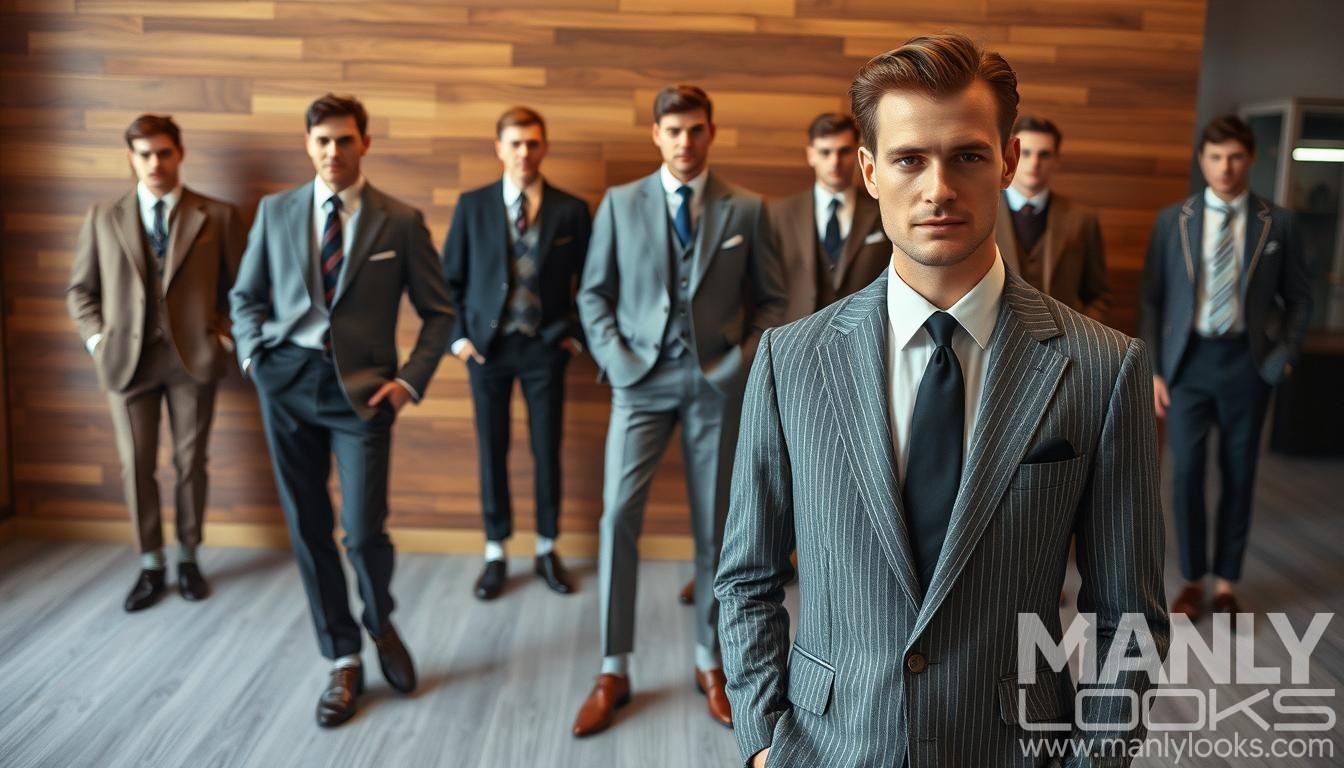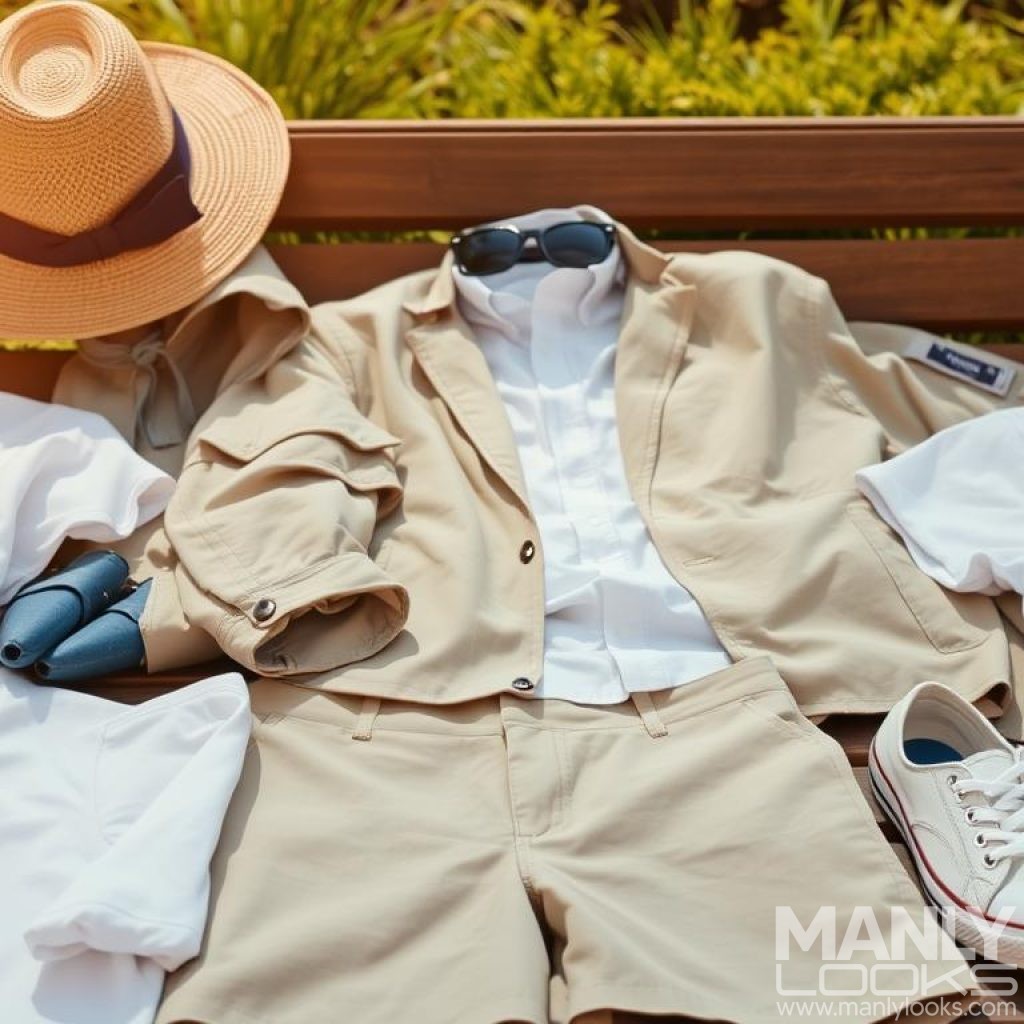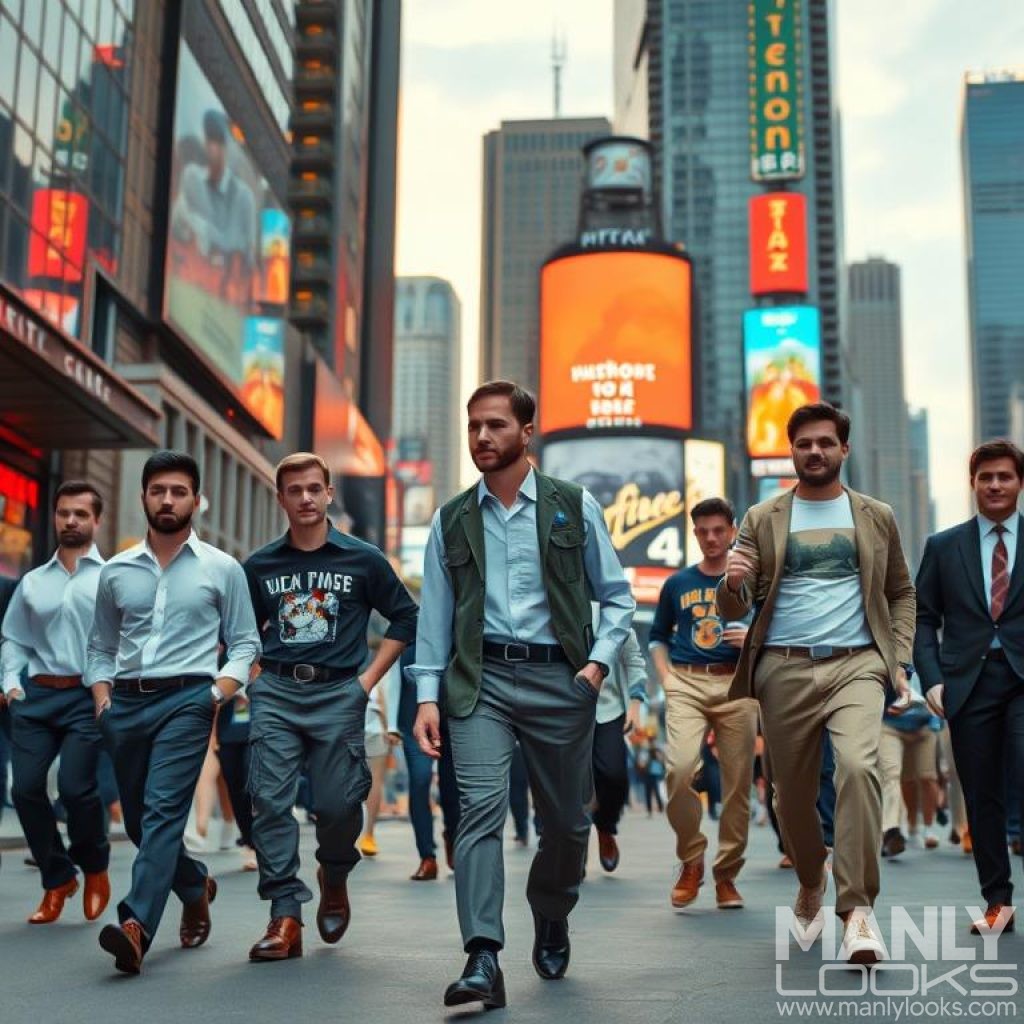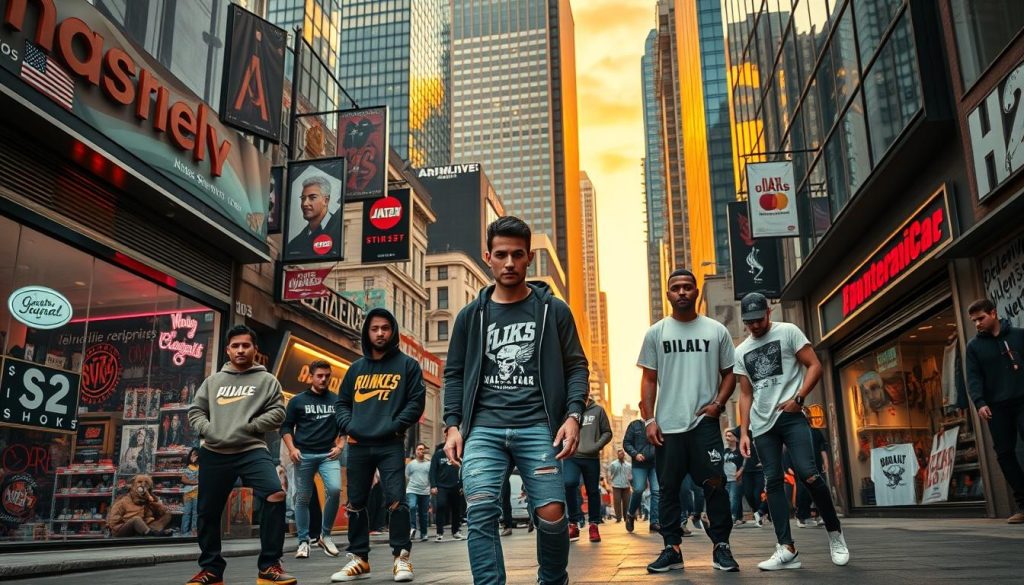The 1950s was a big change for men’s fashion. It moved back to traditional styles after the war. Men’s clothing became more formal and elegant, showing the culture and society of the time.
Elegance and sophistication were big in men’s fashion then. Hollywood and the new youth culture had a big impact. The styles of that time, like tailored suits and classic accessories, are loved today.
Key Takeaways
- The 1950s saw a resurgence in traditional men’s fashion.
- Hollywood and youth culture significantly influenced men’s style.
- Tailored suits and classic accessories defined the era’s fashion.
- Men’s clothing became more formal and elegant.
- The decade’s styles continue to influence men’s fashion.
The Post-War Fashion Revolution
When World War II ended, men’s fashion changed a lot. It moved from military clothes to more casual wear. Many men kept wearing their military outfits even after the war.
From Military Uniforms to Civilian Style
The shift from military to civilian fashion was slow. At first, men wore clothes that looked like their military uniforms. They wore tailored trousers and button-down shirts. But as the economy grew, fashion started to get more relaxed.
Designers mixed military clothes with civilian styles. This created a mix of function and fashion.

Economic Prosperity and Its Impact on Fashion
The post-war economic boom changed men’s fashion a lot. With more money, people spent more on clothes. Men wanted clothes that were both useful and stylish.
The rise of consumer culture led to more fashion choices. This was the time when the gray flannel suit became very popular in men’s fashion.
Economic growth and Hollywood’s influence helped the men’s fashion industry grow. As men became more interested in their looks, the demand for stylish clothes went up. This led to more creativity in men’s fashion.
Understanding 1950s Mens Fashion: An Overview
In the 1950s, men’s fashion showed the decade’s big changes. These changes included moving from post-war times to a youth-led rebellion. This era saw both old and new styles in men’s fashion.

Key Characteristics and Silhouettes
The 1950s men’s fashion was all about clean lines and perfect fits. Suits were tailored to show off broad shoulders and a slim waist. This made men look strong and confident.
The gray flannel suit was a big hit for the professional man. It showed the era’s focus on work and business.
Casual wear also started to take shape. Leisurewear and sportswear became part of everyday fashion. New fabrics and colors made men’s clothes more varied and fun.
The Contrast Between Conformity and Rebellion
The 1950s were not just about following rules; they were also a time of breaking free. Young people, like the greasers and beatniks, had their own styles. They wore leather jackets, jeans, and had cool haircuts.
This mix of following rules and breaking free shaped the decade’s fashion. The 1950s men’s fashion showed the era’s cultural and social changes.
The Business Man’s Wardrobe
The 1950s was a big change for men’s fashion, mainly for businessmen. This time saw a new, professional style that shapes business clothes today.

The Evolution of the Suit
The suit changed a lot in the 1950s, becoming sleeker and more modern. Key elements included:
- Narrower lapels
- Tapered trousers
- A more fitted silhouette
This change came from new textile tech and cultural shifts.
The Gray Flannel Suit Phenomenon
The gray flannel suit was a big deal for 1950s businessmen. It stood for professionalism and fitting in. It was made famous by Sloan Wilson’s “The Man in the Gray Flannel Suit,” showing the everyman executive.
This wasn’t just about the suit. It was about the culture it stood for.
Accessories for the Professional Man
Accessories were key to the professional look. Essential items were:
- Ties, often in subtle patterns
- Pocket squares for a touch of elegance
- Cufflinks to add a personal touch
These items were not just useful. They were also a way to express oneself within professional limits.
In summary, the 1950s businessman’s style was marked by suit evolution, the gray flannel suit’s cultural impact, and the use of accessories. These elements created a unique image of professionalism that shapes men’s fashion today.
The Influence of Hollywood on Men’s Style
In the 1950s, Hollywood was key in shaping men’s fashion. Stars like Marlon Brando and James Dean led the way. The movies became a big influence, as men looked to their favorite stars for style tips.

Hollywood’s impact went beyond clothes. It was about the attitude and image that came with them. Marlon Brando’s rugged, rebellious look in “A Streetcar Named Desire” (1951) was a big hit, starting the “rebel look” trend.
Marlon Brando and the Rebel Look
Brando’s role in “A Streetcar Named Desire” changed men’s fashion. His style, with tight T-shirts and jeans, stood for rebellion. This look was not just about the clothes; it was about the attitude and confidence that came with wearing them.
Young men started to follow Brando’s style, moving away from the formal clothes of the past. This change was a big shift towards a more casual fashion.
James Dean and the Birth of Cool
James Dean made the “rebel look” even more popular with his roles in “Rebel Without a Cause” (1955) and “Giant” (1956). His style, with red windbreaker jackets and white T-shirts, was the ultimate cool look. His mix of vulnerability and toughness made him a fashion icon.
Dean’s influence wasn’t just in his clothes. It was also in how he carried himself, showing a sense of coolness that many wanted to copy.
Casual Revolution: The Birth of American Leisurewear
In the 1950s, American men’s fashion changed a lot. People moved to the suburbs and wanted comfy clothes. This led to a big shift in how men dressed.

Weekend Attire and Suburban Style
Suburbs grew, and so did the idea of weekend clothes. Men started wearing khaki pants and casual shirts. These were more comfy than suits and ties.
Suburban life meant a more relaxed weekend. Men could enjoy hobbies like golf and gardening in their comfy clothes. This made casual wear a big part of life.
The Rise of Sportswear in Everyday Fashion
Sportswear, once just for sports, became a daily fashion item. Sweatshirts, tennis shirts, and casual pants were now part of everyday wear.
Sportswear made clothes more comfy and practical. It changed men’s fashion to be more casual. This showed how culture was changing in the 1950s.
The 1950s were key for men’s fashion. They moved from formal to casual and comfy clothes. This change was big for future fashion trends.
Essential Items in a 1950s Man’s Wardrobe
The post-war era brought big changes to men’s fashion. The 1950s introduced key items that shaped the decade’s style. Men’s wardrobes mixed formal and casual, showing the era’s prosperity.

Shirts and Sweaters
Shirts in the 1950s were made from cotton or linen. They came in many styles, like the Oxford button-down. Sweaters, worn over shirts, added a casual touch. Crew-neck and V-neck sweaters were favorites, made from wool or cotton.
Trousers and Denim
Trousers were key in a 1950s man’s wardrobe. They were made from wool and cotton. Jeans, or denim trousers, were popular among the young, thanks to icons like James Dean. They were straight-legged and perfect for casual days.
Outerwear Options
Outerwear in the 1950s offered both style and function. Leather jackets symbolized rebellion. Trench coats and overcoats were formal choices for cold weather. These pieces kept men warm and made a fashion statement.
The 1950s man’s wardrobe showed the era’s values and cultural shifts. It mixed old traditions with new trends. The decade’s essential items set the stage for future men’s fashion.
The Greaser Subculture and Its Fashion Statement
Greasers emerged in the 1950s, leaving a lasting impact on men’s fashion. They loved motorcycles, rock ‘n’ roll, and unique clothes. Their style was bold and rebellious, showing who they were and what they believed in.

Leather Jackets and Denim
Leather jackets and denim were key to the greaser look. These items were practical and carried deep meaning. Leather jackets showed toughness, while denim jeans were durable and comfy.
This mix of leather and denim made a statement. It was rugged yet stylish, attracting young men who sought freedom and nonconformity.
From Counterculture to Mainstream
The greaser style became more popular, influencing mainstream fashion. The rebellious look of greasers drew attention, making it a trend. By the late 1950s, 1950s fashion men started to embrace casual and bold styles.
This shift in fashion was huge, opening doors for new trends. Greaser fashion’s legacy lives on, with leather jackets and denim remaining popular today.
Ivy League Style: The Collegiate Look
The 1950s Ivy League style was more than a trend; it was a cultural movement. It defined the era’s look for college students. This style, known for its preppy vibe, influenced men’s fashion across the U.S.

Oxford Button-Downs and Khakis
Oxford button-down shirts and khaki pants were key to Ivy League style. These pieces were both practical and stylish. They showed the Ivy League crowd’s laid-back yet refined attitude.
Oxford button-down shirts were a symbol of the preppy look. Khaki pants were a comfy, versatile choice compared to formal trousers.
The Preppy Aesthetic and Its Influence
The Ivy League style went beyond clothes to a whole lifestyle. It shaped how men looked and dressed. The style’s focus on clean-cut looks and classic clothes influenced men everywhere.
This style left a big mark on men’s fashion in the 1950s. It’s seen in today’s fashion, like the lasting appeal of Oxford shirts and khaki pants. The Ivy League style showed the values of its time and helped shape men’s fashion for years to come.
Footwear Trends in the 1950s
In the 1950s, men’s shoes changed a lot. They went from classic dress shoes to casual, rebellious styles. This change showed the decade’s cultural and social shifts. Different shoes emerged for various occasions and subcultures.

Oxford Shoes and Loafers
Oxford shoes were a big deal in the 1950s. They had a closed lacing system and looked sleek. They were perfect for formal events and were loved by businessmen.
Loafers, on the other hand, were more laid-back. They were great for casual and semi-formal events. They offered a relaxed look without sacrificing style.
Saddle Shoes and Bucks
Saddle shoes were a hit with the young crowd. They had a unique saddle-shaped decoration. They were comfy and stylish, perfect for “sock hop” culture.
Bucks, made from suede, were also trendy. They were worn with casual weekend outfits. They added a touch of style to everyday looks.
Boots and Specialty Footwear
Boots, like cowboy and engineer boots, symbolized rebellion. They were popular among greasers. Specialty shoes, like creepers and brothel creepers, also became fashionable.
These styles were linked to certain subcultures. They were a way for people to express themselves through fashion.
1950s Men’s Hairstyles and Grooming
In the 1950s, men’s fashion wasn’t just about clothes. It also included unique hairstyles and grooming habits. This era saw men focusing more on their looks than ever before.

The Pompadour and Other Popular Cuts
The pompadour was a standout hairstyle of the 1950s. It was sleek, combed back, and had height at the front. Elvis Presley and James Dean made it famous, linking it to the era’s youth culture.
Other styles like the crew cut, quiff, and slicked-back look were also big. Each had its own charm and meaning.
Grooming Products and Practices
Grooming products were key for 1950s hairstyles. Men used pomade, hair cream, and bay rum to style and smell good. These items became easier to find thanks to consumer culture.
Going to the barber was also a must. It kept their hair neat and in style.
Accessories That Defined 1950s Fashion Men
The 1950s was a big change for men’s fashion, with accessories being key. They weren’t just extras; they were vital to finish an outfit and show who you were.

Hats and Their Declining Popularity
In the early 1950s, hats were a must-have for men, showing respect and formality. But as the decade went on, hats fell out of favor, mainly with younger guys who liked a more relaxed look. Fedoras and trilby hats were favorites for some, but hats were no longer as common.
Ties, Pocket Squares, and Cufflinks
Ties, pocket squares, and cufflinks brought elegance to a man’s look. Bold, colorful ties were big, with fun patterns and designs. Pocket squares added color to a suit, and cufflinks decorated shirt cuffs. These items let men show their style and add a unique touch to their clothes.
Watches and Jewelry
Watches and jewelry were also key in 1950s men’s fashion. Wristwatches became more affordable and popular, with brands like Rolex and Omega leading the way. Jewelry, like cufflinks and tie clips, was used to enhance outfits. But men’s jewelry was simple and elegant, focusing on subtlety over boldness.
Accessories were essential in 1950s men’s fashion, letting people show their style and personality. As
“Fashion is not just about clothes; it’s about the attitude and confidence that comes with wearing them.”
This quote captures the spirit of 1950s men’s fashion, where accessories were used to make a statement and complete an outfit.
Color Palettes and Patterns of the Era
Men’s fashion in the 1950s saw big changes in color and texture. As the decade went on, men’s clothes started to show off their personality more. This change was part of bigger cultural and social shifts.
The Shift from Muted to Bold
In the early 1950s, men’s clothes were mostly subdued, like during wartime. But as the decade moved forward, colors got bolder and brighter. This was thanks to the post-war prosperity, which let people try new things in fashion. Bright colors and bold stripes became common, even in everyday clothes.

Popular Prints and Textures
The 1950s also brought new prints and textures to men’s fashion. Some key trends included:
- Plaid and checkered patterns, seen in shirts and trousers.
- Stripes, found in both formal and casual outfits.
- Houndstooth and other subtle patterns, adding flair to suits and jackets.
New fabrics like wool, tweed, and corduroy became popular. They added depth and showed the era’s focus on quality and lasting materials.
The mix of colors, patterns, and textures made 1950s men’s fashion unique. It set the stage for future fashion trends.
How 1950s Men Fashion Continues to Influence Modern Style
The 1950s men’s fashion has left a mark on today’s style. It shaped how men dress and influenced fashion culture. This era’s impact is clear in modern fashion.

Enduring Elements in Contemporary Fashion
Many parts of 1950s men’s fashion are now part of our everyday clothes. The classic suit is a key piece of professional wear, with its look and feel unchanged. Oxford shoes and loafers are also favorites, showing the era’s lasting effect on fashion.
The preppy look, with Oxford button-down shirts and khaki pants, is popular again. Young people love these classic pieces. They show how 1950s fashion is always relevant in men’s style.
Revival Trends and Nostalgic Callbacks
Lately, 1950s-inspired trends are back, with designers using leather jackets and saddle shoes. This love for 1950s fashion also shows in hair, with the pompadour hairstyle making a comeback.
Fashion trends come and go, but 1950s styles will always be part of it. Knowing where today’s trends come from helps us understand fashion’s future. The 1950s men’s fashion legacy will keep shaping our style.
Conclusion: The Legacy of 1950s Men’s Fashion
The 1950s was a time of big change for men’s fashion. It moved from strict post-war styles to more relaxed and colorful looks. This decade saw both traditional and bold fashion trends emerge.
Today, you can see the 1950s’ fashion influence in modern styles. Designers often mix old and new, creating fresh looks. The 1950s mens fashion is a big part of today’s men’s style, from classic suits to the cool greaser look.
Learning about the 1950s’ fashion evolution helps us understand our style choices today. The 1950s men’s fashion will keep shaping men’s fashion in the future. Its classic styles and lasting impact on today’s clothes are undeniable.




